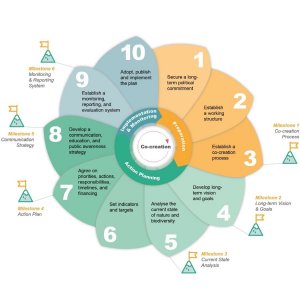
The EU may be deep in winter, but we have greening on our minds. The stage for a flourishing spring was set at the kick off of UNPplus, a new Horizon Europe project coordinated by Politecnico Milano and dedicated to supporting cities in crafting and implementing Urban Nature Plans (UNPs, former Urban Greening Plans). UNPs stand out from other greening approaches in that they help local authorities integrate existing policies, measures and strategies related to urban greening at all governance levels and across planning departments (e.g., housing, mobility, utilities, and public health). These are no-regret measures that offer cities an actionable and relevant strategy for addressing the impact of climate change, ecological degradation, and biodiversity loss on human health and the environment.
UNPplus was developed in response to the EU Biodiversity Strategy for 2030, which calls on all cities over 20,000 to invest in urban greening by creating an Urban Nature Plan (UNP). Support for this can be found in the recently piloted, Urban Nature Plan Guidance and Toolkit, a resource that forms the foundation of UNPplus’s theory of change.
The Urban Nature Plan Guidance and Toolkit was born in 2021, when ICLEI Europe and Eurocities partnered in a service contract for the European Commission. The guidance is the fruit of a year-long consultation process with over 100 key stakeholders from 41 cities representing 16 European countries. The resource provides the background, rationale and key elements to enhance and restore urban nature and biodiversity for the benefit of people and the planet, within a context of political commitment and in partnership with residents and stakeholders.
The plan consists of 10 steps:
1) Secure a long-term political commitment; 2) establish a working structure; 3) establish a co-creation process; 4) develop long-term vision and goals; 5) analyse the current state of nature and biodiversity; 6) set indicators and targets; 7) agree on priorities, actions, responsibilities, timelines, and financing; 8) develop a communication, education, and public awareness strategy; 9) establish a monitoring, reporting, and evaluation system; 10) adopt, publish, and implement the plan.
Cross-cutting all the steps is political commitment and meaningful engagement of different levels of government, citizens, and stakeholders.
“Urban Nature Plans are an integrated planning framework that emphasise the important role that nature plays in meeting a city’s development goals. At ICLEI Europe, we hear from cities all the time about competing land use challenges. Cities highlight an increasing need for coordination across sectors like housing, mobility, and urban greening. UNPs have the potential to address these challenges.” Anna Bruen
Piloted within the Horizon 2020 Project CLEVER Cities, this guidance is now the core component of UNPplus. This project is working with 5 cities - Paris, Barcelona, Belgrade, Mannheim, and Burgas to test, refine, and enhance the existing guidance. Learn about Quito and Belgrade’s experiences with UNPs (pg. 20), or read the guidance. What might an urban greening plan look like in your city?
